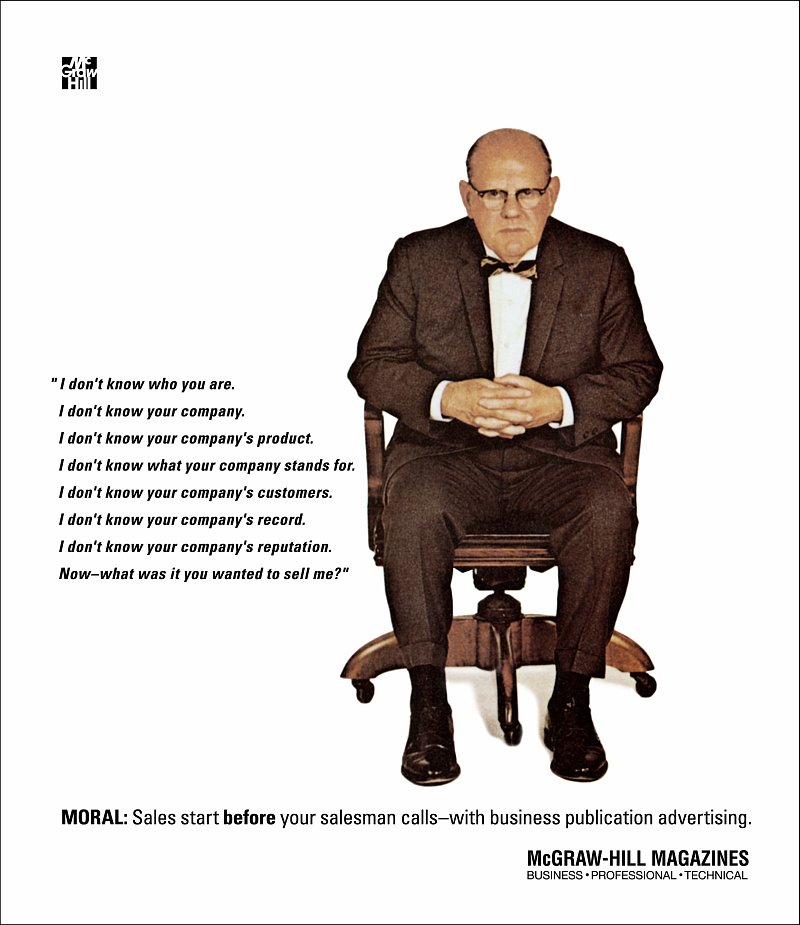Back in the early 1940s, Rosser Reeves of Ted Bates & Company coined the phrase “USP – Unique Selling Proposition.” The term referred to a having, finding or creating a distinctive point of view or reason to buy that is wholly different from the competitions’.
But as a catchphrase, USP is so 70-years-ago!
In the 80’s, marketing agencies, HR consultants and motivational speakers started using the term “elevator pitch,” which kinda says the same thing: What is so special about you (or your company, or your product) that you can express it in just 30 seconds on the ride up the elevator and expect the listener to get it? We hear that term a lot in angel and investor meetings.
More recently, we find ourselves using the phrase “value proposition.” And we’ve shorted the time to about 5 seconds, but we’ll settle for 30, just as long as it clearly tells the story.
Your value proposition is the answer to the question “what customer objective does my company help to achieve better than anyone or anything else?”
Whichever term you favor, USP, elevator pitch, or value proposition, without it, without a good one, you’re dead! If you can’t very quickly describe what makes you, your product, your service or your company truly special in the eyes of the customer, don’t expect your customer to do it for you. By default, they’ll just put you on the shelf called “commodity,” and there you’ll stay.
Every business, no matter what the business, starts out with the same baseline of customer fulfillment as its competition. If you have a fast food restaurant, for example, you might say your value proposition is fresh entrees at reasonable prices. But then, doesn’t the competing restaurant down the road also say that? So that alone doesn’t really make you special, does it? Poof, you’re a commodity! You’re just the same as everybody else.
On the other hand, your value proposition has to be one that is not merely unique but deserves an exclamation point in the eyes of your customer. It has to create a real sense of Wow! or there really is no value, just proposition. What can you say that captures the imagination and puts you in a class all your own? That’s at the very heart of making a sale or losing out on one.
I’ll be honest, defining your value proposition takes some real corporate soul-searching at the most fundamental level. It requires seeing yourself from your competitors’ customers’ point of view. It may even require re-inventing your organization so that there’s an entirely new but better value proposition than the one you’re claiming now.
 Commit to asking yourself, just as soon as you finish reading this post, “what’s our value proposition?” Ask your associates and see if their answers agree with your own, and if they can articulate it in less than 90 seconds. Aim for 30. (For my company, we can do it in two seconds: “Agent of Change.” We even own the registered trademark on it!)
Commit to asking yourself, just as soon as you finish reading this post, “what’s our value proposition?” Ask your associates and see if their answers agree with your own, and if they can articulate it in less than 90 seconds. Aim for 30. (For my company, we can do it in two seconds: “Agent of Change.” We even own the registered trademark on it!)
Your value proposition is the very cornerstone of your business. All sales and marketing must emanate from it. The stronger your value proposition is…
…and the more clearly it expresses your unique ability to improve your customer’s lives…
…and the most concisely you can articulate it between elevator floors…
…the more confident you can be in betting on your company’s success!
You’d be hard-pressed to find someone who’s going to describe today’s economic marketplace as anything but temperamental. The natural inclination is to take a defensive hunker-down mentality, downsize, and play it safe. The truth is, however, you should be looking at things (especially your customers) quite differently.
Most businesses look at their customers from the inside-out based on what they want to deliver. (In other words, you’ve created your own Kool-Aid and you’re drinking it, so your customers should too, right?) But customers see any business from the opposite perspective, from the outside-in.
Let’s take these two views apart for a moment.
Inside-Out thinking begins by asking, “What are we good at? What are our capabilities and products? How can we use our resources more efficiently?” This thinking limits the company’s business opportunities because it means the company is less sensitive to how the customer is interfacing with the market. They’ve slipped into thinking it’s “all about us and what we sell.” Inside-Out companies are surprised by poor sales results. They don’t feel threatened when a new competitor enters the market. They’re out of touch with what value they really bring – or don’t bring – to their customers, or what their customers think of them compared to competitors. In short, their mindset is “Here are our products and services and this is how we help you.” The problem with this approach is that it relies on your customers having to work to find a place for your solutions in their lives.
Alternatively, companies that think Outside-In focus on the customers’ point-of-view. They stand in the customer’s shoes and view everything the company does through the customer’s eyes. They depend on marketing to increase the conversation they have with their customers which in turn allows them to seize on business-building opportunities. They ask their customers what their upcoming needs are and then figure out how to give it to them. By shifting the focus so significantly, they open up a much broader set of opportunities. These companies don’t wait around for change to happen but rather they create change by seeing their world through their customers’ eyes, allowing them to more quickly meet the customers’ needs.

The first tablet PC's were designed based on the manufacturer's point-of-view; Apple's iPad was designed from the consumers'.
A perfect demonstration of the difference is tablet computing. Tablets have been around for years, fundamentally as flat computers…in search of markets who need them. Apple, on the other hand, looked at how consumers use the Internet, music, photos and video content, and came up with a convenient form factor that is, in essence, an Internet devise, not a computer. The rest, as they say, is history. That’s Outside-In thinking at its best.
So what’s this all mean? Well, fundamentally, if you’re not stepping out of your comfort zone and taking a hard, honest look at your business and its products through your customers’ (and non-customers’) eyes, you’re putting a lid on your growth. If you’re not communicating to your customers on their terms, they simply won’t care. Having an Outside-In attitude ensures that your company delivers the value buyers actually understand and appreciate. Conversely, the old phrase “if you keep doing what you’ve been doing, you’ll keep getting the results you’ve been getting” has never been more true.
Alright, business hasn’t turned around as quickly as you’d like – or as quickly as anyone would like. So your customers aren’t throwing their spending money at you any more than you’re shelling out dollars to hire additional staff, add new locations or expand your advertising reach.
Instead, if you’re like most companies, you’re continuing to be as parsimonious with your spending and investing as good business judgment dictates, right? That means you’re more focused on sales than on marketing, since marketing means spending money whereas sales means making money, right again?
Many businesses have grown their sales force while decimating their marketing departments. They’ve turned from brand-building to such “instant gratification” sales-based marketing strategies as direct response and SEO. At the same time, they’re making price the deciding factor.
What could possibly be wrong with that?
So let me propose two basic flaws in that kind of approach.
First, the further away from image and brand marketing you move, the less the customer is predisposed to buy from you regardless of price, since your brand is no longer the top-of-mind preferred choice. That means A) you have to wait until the customer is ready to buy and not a second before, and B) you are now set up for trading exclusively on price since your value proposition has taken a distant back seat…and there’s always a competitor who will come along with a cheaper product or service.
The second strategic flaw is that you’re now doing exactly what your competition is doing, hunkering down and playing the DR/sales/price game at precisely the time advertising rates are the most affordable they’ve ever been. Today, you can negotiate the most advantageous ad programs and one-up your competition with strong visibility while they’re still virtually invisible.
The opposing argument might be that in this sucky economy consumers are more price-focused than brand focused. And yet…
Why is it that sales of Apple’s iPad, an absolutely non-necessary (but really great) product, are booming? With each new iteration of the iPad, a $600 – $800 purchase, there are lines of anxious shoppers waiting outside the Apple Store. Simply, Apple presents a fantastic value proposition in its advertising that has nothing to do with price. The Apple brand and the iPad experience are king. Their strategy is so successful that in 2011, Apple sold more iPads in its last quarter than HP sold desktop computers all year!
The true job of advertising and marketing is to establish a consumer’s desire in advance of asking for the order. Without this first stage, building desire and brand equity, the selling process is exponentially more difficult. Any wonder why the sales cycle for most businesses has doubled or even tripled over the past few years as marketing budgets have been cut?
This is nothing new. In fact, the business publisher McGraw Hill addressed this very issue in a brilliant ad that ran in the early 1960s. In essence, the ad demonstrated that without marketing laying the foundation of understanding and desire prior to the sale, the barrier is significant.
So you’ve been given a gift, as it were, in the form of a recession. From a marketing perspective, your competitors are asleep at the wheel, and you can afford marketing visibility as you never have before. Here’s your chance to let them suffer the recession while you profit from it. How will you handle the opportunity?
You spend thousands, perhaps tens or even hundreds of thousands of dollars on your advertising and yet you’re still completely invisible to most of your audience. What’s going on? Why after all this time and all those dollars are you still the best-kept-secret in town?
Well, think about it from another perspective.
Do you need a plumber right at this moment? (If you do, let’s pretend you don’t for the sake of this illustration.) People who don’t need plumbers probably don’t see all those plumber ads in the papers, or on bus benches, or hear them on the radio. Oh, they’re there all right, lots of them, but to you, they’re completely invisible…Unless. The “unless” is if the ad happens to be really creative or interesting in some way that grabs you regardless. But most plumber ads are pretty much what you expect, and are therefore completely unnoticeable to the 98% of the audience who is not at-need. (You see where I’m going with this…)
In this case, the best that the plumber/advertiser can hope for is an equal shot along with all his competition at the time the faucet starts dripping, and not a moment before. But let’s take the plumber whose advertising is really fresh and interesting, that makes people take notice even when everything is fine. Then he’s going to be the first name on people’s minds when the sink backs up.
Human beings only pay attention to the things that interest them, and block out all the rest. It’s a natural defense mechanism that helps the brain cope with too much information. And only those things that are of immediate interest have a way of showing up as if by magic – such as when you are shopping for a particular car and suddenly, every car on the highway is that car!
For fun, try this wonderful YouTube demonstration:
[youtube=http://www.youtube.com/watch?feature=player_embedded&v=Ahg6qcgoay4]
It’s easy to be visible to your audience when there’s an immediate need or urgent desire. But imagine how completely invisible you are to them prior to that need – which is precisely when you most want to reach them! The more “expected” your advertising, the more invisible you become. You’re just another plumber advertising to people whose toilet’s are flushing just fine.
If you want to be noticed, you have to be noticeable. You need to rise above the general noise level with advertising and marketing that is different, fresh, unconventional and unexpected. You have to be willing to step out on a limb and surprise the audience and perhaps yourself.
I realize that only a tiny percentage of marketers will actually take this to heart and do anything amazing. That’s why 95% of ads in any medium – print, TV, billboards, direct mail – or for any industry – beer, office supplies, funeral homes, or financial services – are doomed before they leave the production house. But for those who take the risk, the reward is top-of-mind awareness before, during, and after the need.
That’s an ROI I’d take any day.
– By Dan Katz, Agent of Change © 2012 LA ads – A Marketing Agency
I’m sure you remember those wonderful fill-in-the-blanks books, “Mad Libs.” You know, you just insert your own verb, noun or adjective in the blanks and see how silly the sentences come out. Mad Libs are great for kids and fun at parties, but they have no place in expressing your marketing message. Yet, as I look through the pages of ads in magazines, or surf companies on the web, I see all kinds of Mad Lib slogans and taglines, which are in effect condensed marketing messages:
At the very least, many marketing messages are so generic, any competitor in the same industry could put their name in the space:
They don’t communicate anything unique about the marketer other than the category in which they operate, putting them at the same level as everyone else who provides a similar product or service.
By comparison, here are a few examples of taglines past and present that are truly distinctive and demonstrate a unique selling proposition:
If you’re in the former camp instead of the latter, it’s a perfect time to re-think what you have to say to prospective customers that gives your firm the edge.
As you begin looking forward to the new year, it’s worthwhile to look backwards to some of the strategies and tactics you’re bringing into 2012…starting with your basic marketing message. Ask yourself, is our message so familiar, expected or generic that it could apply to any of our competitors? Does it fully express our unique point of difference? Is it fresh and “sticky”?
Without having a strong point of view and a distinctive message risks your customers seeing your products or service as a commodity, and they’ll be happy to shop your competitors when they think price is the only difference.
This may require a bit of corporate soul-searching, but it belongs on your marketing must-do list for 2012. Otherwise, you’re just [ verb ]-ing your precious marketing dollars [ preposition and place ].
by Dan Katz © 2012